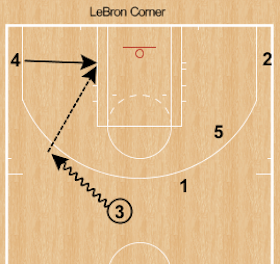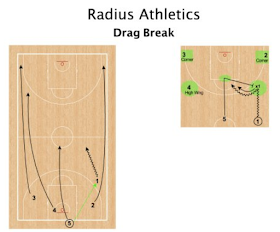The "offseason" begs us to apply offensive concepts. If mentally constipated, research more.
Adapt your offense to the defense. Aggressive defense exposes itself against aggressive screening and misdirection (back cuts). Savvy players make multiple actions (cutting and passing) to create chaos. The best teams become offensive juggernauts.
I don't expect middle schoolers to execute an encyclopedia of sets. Run the same concept from different formations. Run the same action from 'horns', 1-4 high, 1-3-1, or even 2-3 (two guard front) from the post to the wing. That expands the playbook without brain strain.
Twin post action translates into 1-3-1 formation. If we 'sell' DHO then it becomes a slip for a possible layup. If it doesn't happen, it sets up an isolation for 5, or maybe high-low with 4, or something for one on a delayed cut. That's up to the players, as it should be.
Here are a quintet of diagrams of well-constructed and executed actions from the video. Not all are classically backdoor, which I define as a cut toward the ball, then away from the ball.
In a developmental program, introduce a variety of educational actions like these.
Be eclectic. Embrace the concepts, then apply what fits.





































